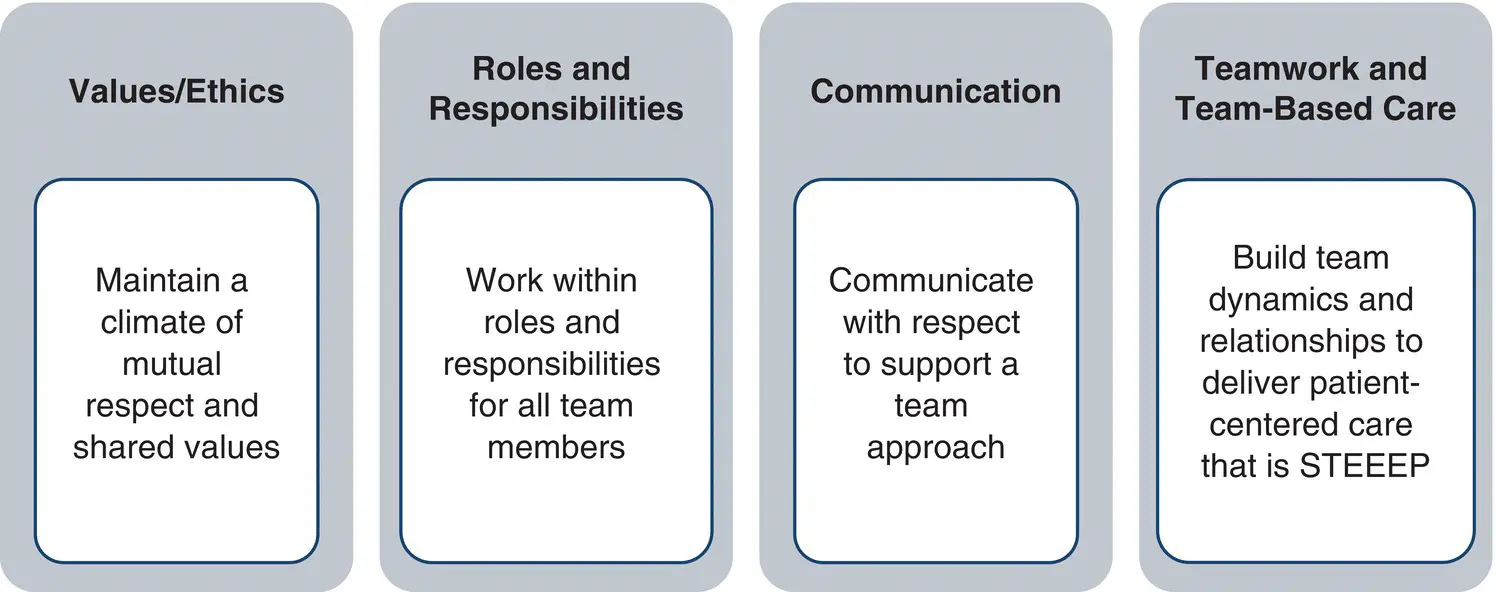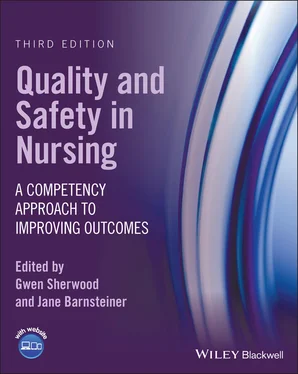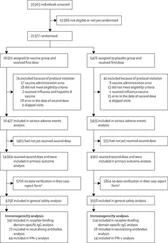Quality and Safety in Nursing
Здесь есть возможность читать онлайн «Quality and Safety in Nursing» — ознакомительный отрывок электронной книги совершенно бесплатно, а после прочтения отрывка купить полную версию. В некоторых случаях можно слушать аудио, скачать через торрент в формате fb2 и присутствует краткое содержание. Жанр: unrecognised, на английском языке. Описание произведения, (предисловие) а так же отзывы посетителей доступны на портале библиотеки ЛибКат.
- Название:Quality and Safety in Nursing
- Автор:
- Жанр:
- Год:неизвестен
- ISBN:нет данных
- Рейтинг книги:5 / 5. Голосов: 1
-
Избранное:Добавить в избранное
- Отзывы:
-
Ваша оценка:
- 100
- 1
- 2
- 3
- 4
- 5
Quality and Safety in Nursing: краткое содержание, описание и аннотация
Предлагаем к чтению аннотацию, описание, краткое содержание или предисловие (зависит от того, что написал сам автор книги «Quality and Safety in Nursing»). Если вы не нашли необходимую информацию о книге — напишите в комментариях, мы постараемся отыскать её.
Quality and Safety in Nursing
Future of Nursing
Quality and Safety in Nursing, Third Edition
Quality and Safety in Nursing — читать онлайн ознакомительный отрывок
Ниже представлен текст книги, разбитый по страницам. Система сохранения места последней прочитанной страницы, позволяет с удобством читать онлайн бесплатно книгу «Quality and Safety in Nursing», без необходимости каждый раз заново искать на чём Вы остановились. Поставьте закладку, и сможете в любой момент перейти на страницу, на которой закончили чтение.
Интервал:
Закладка:
Textbox 1.2Eight Recommendations for Improving Quality and Safety
Ensure leaders establish and sustain a safety culture
Create centralized and coordinated oversight for patient safety
Create a common set of safety metrics of meaningful outcomes
Increase research funding to examine patient safety and improvement science
Address safety across the entire care continuum
Support the health care workforce
Partner with patients and families for safest care
Ensure safe technology used optimally to improve patient safety
The global report used the same STEEEP model first developed for the 2001 IOM Crossing the Quality Chasm report, but made modifications reflecting new perspectives on equity, equality, social determinants of health, and access to health care ( Figure 1.1).
Systems are hampered by a lack of technology that could drive some improvements, payers and providers are not in alignment, and few resources are allocated for coordinating care for complex conditions. Systems are largely designed for failure, with safety a reactive approach that regulates behavior and inhibits variability, with little effort paid to analyzing system issues.
Quality and safety are dependent on the culture, norms, expectations, and learning environment of systems—that is, hardwired into the organizational mission and vision. To improve, every level of a health care system must be examined to learn how each microsystem interacts within the larger system: how the environment, the organization, workers, and the patient at the center work in synergy (Neuhaus, Lutnæs, and Bergström, 2020). To improve, health professions education should be transformed with a guiding framework based on developing systems thinking for all providers to share in quality and safety improvements.
National Initiatives for Quality and Safety
Many of the improvements in our health care systems are the result of regulatory mandates from groups such as the Joint Commission ( www.jointcommission.org), which grants institutional accreditation that opens the possibility of different aspects of federal funding (Wachter, 2004, 2010). The Joint Commission issues an annual list of National Patient Safety goals to provide guidance in key areas of high vulnerability and share evidence for solutions by emphasizing a systematic process for quality improvement, patient safety, and monitoring outcomes ( https://www.jointcommission.org/standards/national‐patient‐safety‐goals). The Joint Commission requires health care delivery systems to establish a code of conduct to eliminate disruptive behavior among health care professionals, a major threat to safety, as well as a process for managing such behaviors. Schumann (see Chapter 2) provides a comprehensive description of national groups related to quality and safety.
The IHI ( www.ihi.org) is a strong advocate for quality and safety innovations, facilitating collaboration among all professions. Its 100,000 and 5 Million Lives campaigns are just two examples of focused collective efforts for improving outcomes. The IHI Triple Aim has three primary goals for health care – improve population health, reduce costs, and improve the quality of care – all of which align with the 2001 IOM STEEEP model. To address concern for the health care workforce, the Triple Aim was replaced with the Quadruple Aim as a more comprehensive model (Bachynsky, 2020).
The Patient Safety Movement Foundation ( https://patientsafetymovement.org) is a nonprofit professional and consumer organization with the aim to “prevent the preventable.” The goal to achieve zero deaths from preventable health care harm is also endorsed by the International Society for Quality in Health Care (ISQua; Goldstein, 2019) and 4,793 hospitals in 48 countries. Others question whether the focus on achieving zero will distract from creating total system safety (Thomas, 2020).
Bold progress will require bold action and collaboration across the world. The WHO issued the Global Patient Safety Action Plan for 2021–2030 (WHO, 2021). The plan requests all member states to recognize the crisis of patient safety by establishing policies and actions to reduce preventable harm. The report issued a set of policy recommendations for global collaboration and coordination to push forward an agenda for patient safety and quality. WHO also established a yearly World Patient Safety Day, celebrated with informative webinars and education sessions to highlight preventable harm.
The formation of the Interprofessional Education Collaborative (IPEC, 2011) is a major achievement impacting quality and safety. Six health care professions collaborated in developing four domains of interprofessional education: values and ethics, roles and responsibilities, communication, and teamwork and team‐based care ( Figure 1.2). The competencies are commensurate with the QSEN competencies. The IPEC competencies were updated in 2016 to include interprofessional collaboration as the overarching domain encompassing the four competencies (IPEC, 2016), now endorsed by more than 16 health care disciplines. The movement for interprofessional education and practice led to US federal funding to establish the National Center for Interprofessional Practice and Education ( https://nexusipe.org). This is a robust clearinghouse for interprofessional practice and education, which are increasingly linked to quality safe care, better care, added value, and healthier communities (Neuhaus et al ., 2020). Interprofessional care, quality and process improvement, and population health management are ways to align education and practice with quality safe care across all aspects of health care (Brandt et al ., 2014; see Chapter 14). These competencies also cross‐walk with the widely disseminated TeamSTEPPS curriculum, made available by AHRQ to develop four main themes: Leadership, Communication, Mutual Support. and Teamwork ( https://www.ahrq.gov/teamstepps/index.html). Each of these has been linked to developing safety culture, and together these competencies are embedded in the QSEN competencies and discussed later in the chapter.

Figure 1.2Interprofessional competency domains for education and practice.
Source: Modified from Interprofessional Education Collaborative Expert Panel (IPEC), 2011, Core Competencies for Interprofessional Collaborative Practice: Report of an Expert Panel . Washington, DC: Interprofessional Education Collaborative.
Many nursing organizations have identified and developed programs to improve quality and safety. For example, the American Association of Critical‐Care Nurses (AACN; www.aacn.org) developed multiple approaches, including a program on healthy work environments focused on teamwork and collaboration. The Nursing Alliance for Quality Care (see Chapter 2) created one organized nursing voice to ensure that (a) patients receive the right care at the right time from the right professional; (b) nurses actively advocate and are accountable for consumer‐centered, high‐quality health care; and (c) policy‐makers recognize the contributions of nurses in advancing consumer‐centered, high‐quality health care.
The American Nurses Association also established the National Database of Nursing Quality Indicators in 1998, which maintains data on sustained improvement in a designated nursing‐sensitive indicator such as staffing, hospital‐acquired pressure ulcers, falls and prevention of injury from falls, staff satisfaction, and pediatric and psychiatric mental health data (see Chapter 2). The Magnet recognition program standards recognize nursing leadership, continuous quality improvement, and organizational culture. In a bold move that helped transform nursing education, prelicensure and graduate nurse competencies were developed by the QSEN project (see Chapter 3).
Читать дальшеИнтервал:
Закладка:
Похожие книги на «Quality and Safety in Nursing»
Представляем Вашему вниманию похожие книги на «Quality and Safety in Nursing» списком для выбора. Мы отобрали схожую по названию и смыслу литературу в надежде предоставить читателям больше вариантов отыскать новые, интересные, ещё непрочитанные произведения.
Обсуждение, отзывы о книге «Quality and Safety in Nursing» и просто собственные мнения читателей. Оставьте ваши комментарии, напишите, что Вы думаете о произведении, его смысле или главных героях. Укажите что конкретно понравилось, а что нет, и почему Вы так считаете.












